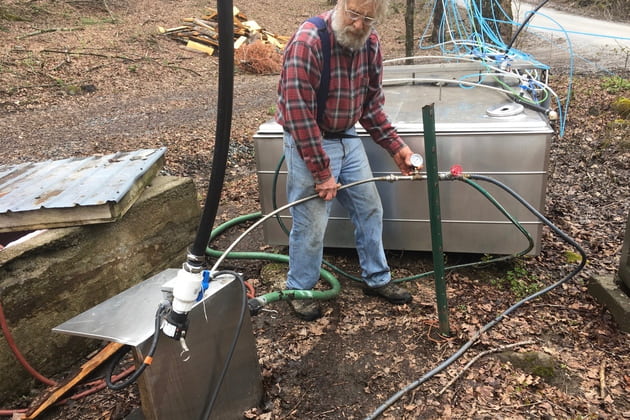Tapping & Tubing
Sugarmaker weighs in on cleaning 3/16 tubing
Arthur Krueger washes tubing with calcium hypochlorite bleach
By ARTHUR KRUEGER | AUGUST 4, 2019
SHREWSBURY, Vt.—He are my 2019 observations on Calcium Hypochlorite bleach for cleaning 3/16” sap tubing at our Krueger-Norton Sugarhouse here in Central Vermont:
After the 2018 season we cleaned our 3/16” tubing system with calcium hypochlorite bleach. This bleaching solution is made by adding 1 pound of “Zappit” Cal-Shock 65 to 200 gallons of water.
On 80 percent of the sugarbush we cleaned the system by pumping up air and the bleach solution through the laterals. Later we cleaned the drops by squirting bleach solution into the spouts using wash bottles.
These spouts were either replaced with new spouts or used bleached spouts for 2019.
(I found that it is possible to easily reuse a 3/16” fitting by boiling it and removing the bit of attached tubing with pliers. The fitting is not damaged by this treatment and is able to maintain high vacuum. We found no difference in performance between these used bleached spouts and brand new spouts.)
On the remaining 20 percent of the system we cleaned both drops and laterals by pumping solution up from the bottom without air.
While the solution was being pumped up, the drops were opened sequentially allowing any old sap to be pushed out and letting them fill with bleach solution.
Then they were closed, keeping them full of solution. The drops and spouts were 4 years old in 2019.
On this section we were apparently able to maintain a sufficient contact time for the bleach to have full effect.
This section of the bush has historically lagged in production and it is not as well thinned. Being the lowest section of the bush the elevation of the drops above the bottom of the laterals is not as high as in the rest of the bush. My educated guess is that the vacuum here is about 12” Hg, while the remainder of the bush is above 20 Hg.
Toward the end of the 2019 season this 20 percent section of the bush was doing noticeably better on a per tap basis than the other 80 percent. At the very end of the season we were getting 40 percent of our sap from this section.
There were no negative effects of bleaching with calcium hypochlorite. No flavor problems, no increased squirrel damage, and no discernible damage to tubing and fittings.
This bleach as it degrades turns into lime and has a slightly bitter taste that seems to deter squirrels.
This is in sharp contrast to the sodium based household bleach that we used several decades ago, which degrades into salt and definitely attracted squirrels.
The tubing was visually clean with very few yeast particles. The sap was discernibly clearer than in past years.
The bleach in the laterals neutralizes within a week. It degrades from both sunlight and contact with organic material.
The bleach in dark tanks or mainlines may take several months to neutralize.
There appeared to be little or no clogging of the laterals due to yeast build up. Any clogging was due to the wood chips from tapping and was easily remedied.
The whole system appeared to work better. We had high vacuums throughout the season, getting readings of 25” Hg in places where the elevation was sufficient.
Based on our good results with the 20 percent part of the sugarbush, this year we cleaned the entire system from the bottom with the bleaching solution and without air as we detapped. Each drop was entirely filled with bleach.
We even removed the gauges at the top of each lateral and made sure the drop to the gauge was filled with bleach. We will leave the solution in place until fall, when we plan to drain everything and rinse it with water in order to clean out the resulting lime solution.
We used a Pompco SS-275 piston pump with a 1/2 horse motor.
We controlled excess pressure and flow with a boiler drain back into the solution tank.
At these high pressures, the pressure release valve on the pump gets a good work out. Other types of pumps may work also as long as they are high head and low flow. Bigger is not better here. I would not use a pump larger than 1/2 horse.
It takes considerable amount of adjustment of flow with the boiler drain to get this system to work.
In the past we mixed in air, as an air/solution mixture is significantly lighter than a solution-only mixture, and thus had less pressure at the lower part of the system.
With solution-only, the pressure can get really high and you’re pushing both the limits of your plumbing and the pump.
It is important to keep the pressure below 100 psi. If it goes above this it is easy to blow a gasket in the pump, therefore you should have a repair kit on hand. Fortunately this pump is really easy to rebuild.
Our highest taps are 200’ above the pump elevation. We did get good flow to them and could clean 11 or 12 laterals simultaneously. With these pressures you will find all your leaks.
This works best with 3 people in the woods detapping and 1 person at the pump.
Contact with a walkie-talkie is essential and it can take up to a 1/2 hour for the solution to initially get from the pump all the way to the top of the bush.
It is essential for each of the detappers to have chlorine indicator paper on hand to tell when the bleach has filled the lines and reached the top, pushing out all the old sap.
We have valves at the top ends of our mainlines. We leave these open when we first start, to blow out all the old sap and yeast, and we close them when the bleach reaches the top of the mainline.
The detappers then proceed to the top ends of the laterals served by this mainline and work their way down.
There were some glitches at the start, but once these were worked out we were able to detap rapidly.
































